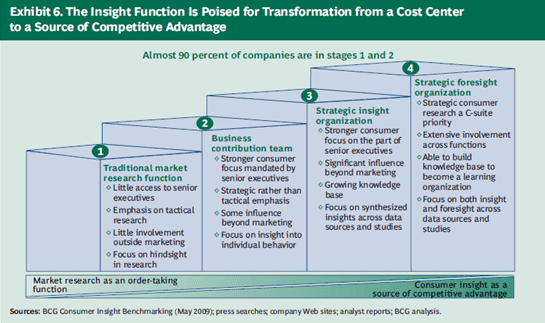Will this be the year that co-creation helps insight functions reach BCG’s illustrious 4th stage?
Mayan Calendars, Wall Street protests, and capsizing ships. Just one month in and it’s already been an eventful year. The excitement doesn’t look like it will let-up in the remaining 11 months, and no doubt we’ll all be affected by these changes at some point. The research industry is no exception. In this post I’ll be making some predictions about how 2012 will be the year that we see some fundamental changes in the ways that brands approach customer insight – and how these changes might just help businesses reach BCG’s illustrious 4th level and become true ‘strategic foresight’ organisations.
BCG have long been predicting that insight functions will increasing have to prove their value by being proactive and future focused. They argue there will be a move from traditional market research functions (level 1) through to strategic foresight that permeates the whole organisation (level 4). The full report can be found here – or if that’s all a bit long-winded then the main chart you need is below:
When BCG first published this report in 2009, they speculated that most companies had insight functions operating in levels 1 and 2, with a handful of the most sophisticated at level 3. But in the last year or so my rolodex has become stuffed full of cards that parade the job titles of ‘foresight manager’ and ‘director of strategic insight.’ Something is clearly changing.
(disclaimer: I’m fully aware that a rolodex is completely outdated, and admitting to using this terribly backwards tool is dangerous when writing an article about future trends. Please be assured that I’m using it in an ironic, hipster way: I really am very cool, of course).
I don’t think that the new titles on these business cards are a PR stunt; I think that there has been a real shift in the way that these foresight managers approach consumers. And for the companies that still need to play catch-up and reach level 3, well, I predict that 2012 will be their year.
How can the companies that still need to catch-up and reach level 3 do so in the most efficient way?
One answer lies in making their research processes more co-creative.
Practically, this means engaging in discrete co-creation assignments. These co-creation assignments will be owned by the insight function, will engage a wide internal stakeholder group, and importantly will asks customers to work with them in order to co-create a solution for a specific brand or innovation question.
We can learn a lot from companies that are already functioning at level 3. These all seem to be businesses have a long-established history of co-creating with customers and include the likes of Starbucks (mystarbuckidea.com), Fiat (the co-created Mio), and Danone’s Activia. Activia is one brand that I helped to co-create with their customers. The brand was faced with 2 challenges: 1) Increase penetration & frequency through communications and 2) Fill the NPD pipeline with brand innovations.
The Activia Advisory Board was the solution: an online community of over 400 women who, over a 4 month period, spent over 1,300 hours online with us. During that time they co-created new insights to underpin the communications strategy, and they also help co-create products to fill the NPD pipeline. In this instance co-creation helped to prove the insight department’s value as strategic thinkers: when tested in IPSOS the insights were 82% more effective and the community had a hand in developing 10 new product propositions.
This example shows that co-creation has a huge impact: it improves the outcome of these one-off insight and innovation projects, and it acts as an efficient means of moving organizations up to BCG’s level 3. But – there’s great potential to leverage this methodology even further: used in the right way, co-creation can thrust companies into BCGs 4th level. And this is what I predict a lot of companies will start to do in 2012.
How exactly can co-creation can help those companies that want to reach level 4?
I’m not sure what BCG, or more importantly the audience of this post would say, but as we enter 2012 I struggled to think of many companies where customer-centricity is pervasive. There are a few notable examples (I’ve linked to these below, and if you don’t know these stories already it’s worth a quick click) but most organisations are still grappling with reaching that 4th level. So what can organisations aiming for that 4th level do?
My view is that co-creation can offer a solution: when adopted as an organisational way of being (and not just confined to a research methodology) there is potential for co-creation to ensure the customer is a c-suite level priority, and that customer-centricity is pervasive across all functions.
Here are a few possible co-creative tactics that might just help organisations jump to the illustrious 4th level:
- Customer Inside: Really let the customer into the guts of the business. Like the Wing Luke museum, why not have the customer physically present on the board? And if that’s not feasible why not have someone with a Customer Insights background as CEO?
- Conversational Learning: Customer insight communities (which cross-functional teams actively engage with) offer an efficient and easy way to bring the customer into day to day decision making.
- Networked Partners: Get rid of the verticals in organizations, in favor of an eco-system approach.
- Co-created Platforms: Like Lego, open up your products and allow customers to make it their own.
- Flexible roles and structures: Like Mozilla, have customer-volunteers sit inside your office and work with you to build what you do.
- Shared success: For all their hard work and loyalty, why not give customers a share in your business? Quirky and Threadless have built the whole businesses on this principle.
So my big prediction for 2012? Some of them may seem a bit radical, but I’d hazard a guess that if any organisation currently sitting at BCGs 3rd level adopted the above co-creative tactics, then 2012 may well be the year that sees them reaching that illustrious 4th level.
Anna Peters is a senior consultant at Promise North America
Based on a presentation by Nick Coates & Anna Peters at MCPC 2011, ‘the co-creative organization of the future’





6 comments
[…] this article, the writer reflects on a report by BCG where it has been predicted that insight functions will […]
The psychodynamic tradition is traditionally strong (as seen in any episode of Mad Men where researchers are featured). While the Freudian qualities have been toned down, it is interesting that more recent practices such as cognitive behavioural therapy has had seemingly little impact on our identification or co-creation of ideas… Osborn and Ernest Dichter still impact so much practice today
Thanks a lot Anna for your explanation! Great! I do agree, and yes, as mr Dichter already stated when he introduced consumer motivation research, psychoanalysts for sure did something right in the search for the real (and unconscious) underpinnings of our behaviour. But I think there are a lot of new scientific findings today that can help us to take the next step. Freud already was a great admirer of Darwin. Ever since the 1980’s evolutionary psychology developed and came up with some great new insights that can help us to bring Freud’s ideas up to speed with the 21st century. Maybe this is a little bit out of the scope of this co-creation discussion but, as an evolutionary psychologist/ consumer researcher, I suggest an evolutionary psychology based framework that can help elaborate on Freud’s great ideas and insight applicable to consumer motivation research and bring us closer to the WHY of consumer behaviour. I am convinced that, with the additional knowledge (insight) of evolutionary psychology, for the brands and businesses who are in-touch with their consumers on a daily basis, knowing what their consumers really motivates for sure will become second nature.
Great article Anna 🙂
As Henry Ford said “if I had asked people what they wanted they would have said a faster horse…”, luckily he didn’t ask them but he knew what they “secretly wanted”, I.e. faster and cheaper mobility. Would consumers have imaged the iPhone, who knows, I doubt it.
To make things simple, at least for product development, I think it boils down to understanding the experience that consumers want, in other words the interactions with the product or service and the emotions that result. It’s then up to the clever industrial designers and engineers to imagine what can be provided. That’s the easy part.
The hard part, as you mentioned Anna, is changing companies so that they open up their processes to people so that they can actually understand their consumers’ desired experiences instead of staying on their ego trips thinking they can do it on their own…
Jon.
I would absolutely agree with you, Marie-Anne: co-creation and deep psychological understanding are not mutually exclusive.
And I think it works two ways:
1. organisations that appreciate the benefit of first uncovering the unconscious needs and desires get better results from co-creation.
2. organisations that understand the value of truly co-creating with consumers develop a better understanding of exactly who their consumers are.
I’ll give you an example of what I mean.
In the co-creation work we do at Promise we always start by creating a safe space, then we move onto looking at the underlying consumer motivations. We use techniques that are predominantly based in the psychoanalytic tradition (although we also draw from other schools of thought too, and if you’re interested here is short article on my views of how researchers should be using these techniques even more http://tinyurl.com/3yb5swt). This approach helps us to reach those unconscious “needs, wants, emotions, motivations, desires, feelings and beliefs”. Other methodologies may stop at this point, but we will take our interpretations back to the consumers – and ask them to co-create with us in order to make sense of it all.
As for the companies that are already co-creating and understand the need to have the consumer infused throughout their organization, maybe these businesses could actually do away with the need for having to constantly re-evaluate the unconscious consumer needs and desires? It might be that, for the brands and businesses who are in-touch with their consumers on a daily basis, knowing what their consumers really want is just second nature?
Very interesting article Anna. One question though: when looking for co-creation to develop consumer insight, how do we deal with the fact that 95% of the real consumer decisions and preferences are based in the non-conscious? For my thesis on consumer insight from an evolutionary psychology perspective I did some research on the definition of consumer insight and summarized the current definition as follows: “consumer insight is a deep psychological understanding of unconscious consumer needs, wants, emotions, motivations, desires, feelings and beliefs”. Understanding is key to insight. The bases of understanding is knowledge about the meaning of specific behaviours, motivations, desires, feelings, beliefs and values. Therefore, to effectively analyse and implement the results of co-creation I think we first need a universal psychological framework of the global consumer. What do you think?